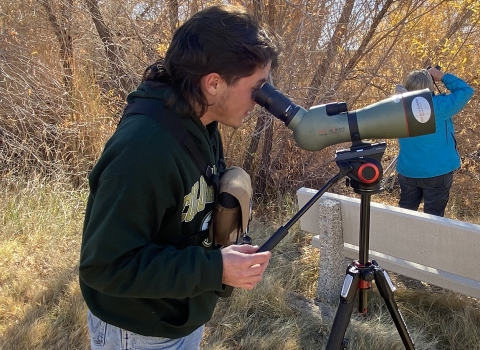News
Desert Tortoise SurvivalThe U.S. Fish and Wildlife Service, the U.S. Geological Survey, the Bureau of Land Management, and the National Park Service, are working to defend the tortoise and its Mojave Desert home from invasive grasses. Hear from the biologists working in the southern Nevada desert what the threats are to the desert tortoise and how you can help.
The Buckwheat and the ButterflyThe "buckwheat and the butterfly” may not sound like a match made in heaven, but the Spring Mountains' dark blue butterfly depends heavily on this yellow, flowering plant from birth until new eggs are laid the following season.
Pahrump Poolfish on the Brink of ExtinctionThere is a rare species of desert fish fighting for its survival in a fresh water pond in the desert landscape of southern Nevada -- the Pahrump poolfish. One of the last remaining populations of the endangered Pahrump poolfish, Empetrichthys latos, is at an alarmingly low number, below 1,000, compared to the 10,000 recorded in 2015. In 2016, U.S. Fish and Wildlife Service biologist, James Harter, and Nevada Department of Wildlife biologist, Kevin Guadalupe, rescued Pahrump poolfish from Lake Harriett at Spring Mountain Ranch State Park outside of Las Vegas, Nevada, and moved them to the Nevada Department of Wildlife’s fish hatchery at the Lake Mead National Recreation Area. The poolfish were taken to the hatchery to protect the species from extinction. According to Harter, it is the Service’s intention to “maintain what population currently exists.” The inter-agency team then drained the water in Lake Harriet and removed any non-native plant and animal species, with the goal of restoring the lake to its original condition before reintroducing the Pahrump poolfish back to the wild.
Team wraps up five-year bird-banding effort in southern Nevada U.S. Fish and Wildlife Service personnel completed the fifth year of banding migratory birds on the Moapa Valley National Wildlife Refuge as part of a project to assess the overall status of birds that migrate to southern Nevada to breed, and their use of habitat on and adjacent to the refuge.
Moapa dace numbers are trending upward The count of Moapa dace shows some good signs for the endangered fish.














